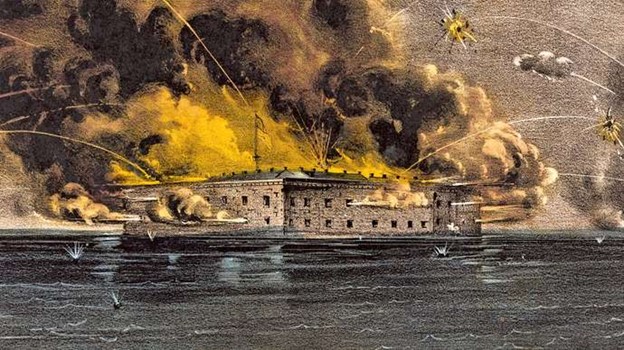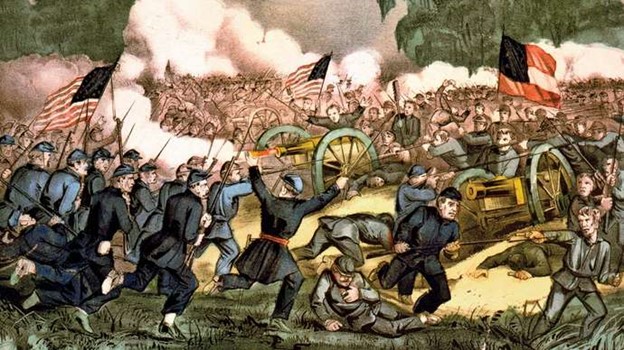The civil war in America was the greatest war that has ever occurred in the history of America. The war between the states, as it was also known, began in 1861, after decades of rumbling tensions between the states in the North and those in the South. The economies of slavery, westward expansion, and the control of that political system were central to the conflict. The states in the South were in a quest to proclaim their authority over the federal government to abolish federal laws that they were not in agreement with, particularly rules that prohibited slavery. Further, the southern states sought to expand slavery into the western territories, an idea that was met with utmost criticism by the northern states that were conformed to the idea of white labor solely. Simultaneously, at that moment, the newly formed republican party was gaining popularity. It comprised members whose political ideology was opposed to the westward expansion of slavery into newly-formed states. These major issues of contention came to a head after the election of President Abraham Lincoln, a Republican, in the year 1860.
Prelude To The War
The root cause of the Civil War can be traced back to the increased divergent opinions between the northern and southern states during the mid-years of the 19th century. Topmost among the issues of contention was the encroachment of slavery into the new states, the magnitude of political power in the North, unlike in the South, the debate on retention of slavery, and states’ rights (Linderman, 2002). Even though these issues of contention had been in existent for several decades, they blew up after the election of Abraham Lincoln into the presidency. Therefore, it was apparent that the secession of the southern states of Texas, Georgia, North Carolina, Mississippi, Tennessee, Alabama, Florida, Louisiana, Virginia, and Arkansas in 1860–1861 was a culmination of decades of growing antagonism over the crucial issue of slavery.
The economy of the states in the North was on a trajectory and rapidly diversifying between 1815-1861. Industrialization began taking root in the North even though agriculture, especially small-scale farming that relied on free labor, was the native economic activity of the inhabitants. The northern population had invested heavily in a wide range of modern transport systems, including railway, roads, and canals (Linderman, 2002); in the monetary sector such as insurance and banking; and in the press and communication industry that featured tools such as newspapers and magazines.
By contrast, the economy of the southern states was predominantly based on plantation farming of commercial crops, majorly cotton, which required heavy input of labor that was sourced from the slave trade. Therefore, the slave trade boomed in the South as compared to the investment and invention of machinery that was rampant in the North. by 1860, 82 percent of the capital that had been invested in industrialization was actually in the free states that did not hold slaves, therefore giving insight into how slavery had taken root in the southern states (Ried, 2014). Seamlessly, the price of cotton had inclined steeply in the early 1850s, and consequently, the slave market increased exponentially such that by 1860, the per capita wealth of Northern whites was nearly half that of the Southern whites.
The advancement of slavery into new territories was not a new issue of contention. The debate had existed as far back as the Northwest Ordinance of 1784 (Ried, 2014). The first of a series of pro-slavery and anti-slavery conflicts over the expansion of the ‘peculiar institution’ into the west, as it was known, began when the congress debated for close to two years to arrive at the Missouri compromise of 1820 even though the state had sought statehood early back in 1818. The westward expansion of slavery was further compounded by the termination of the Mexican-American War in 1848, which led to the new acquisition of roughly 400,000 square miles of land as part of the U.S.A. territory (Linderman, 2002). Over the decade, the rift between the North and the South grew wider, and the political class was unable to contain the dispute by negotiations or compromise whatsoever.
The inhabitants of the North believed that the bondage of slavery needed to be eradicated, while those from the South feared that the ‘peculiar institution’ would be aborted. The two warring parties became even more polarized after Abraham Lincoln, the president of the explicitly anti-slavery Republican Party, clinched the presidency in 1860, leading to the secession of the southern states to form the Confederate States.
The Civil War Events
Following the election of President Abraham Lincoln in March 1861, the first shots of the war were thrown in April of the same year. The garrison of the U.S. Army’s harbor forts in Charleston was left isolated following the secession of South Carolina in December 1860. The newly-formed Confederate government ordered its army to open fire on the Fort on April 12, 1861, under the command of General Beauregard, once it noticed the efforts by the federal government to relieve the fort towards the North (Basler, 1967). After less than two days of bombardment, Major Robert Anderson backed down, leaving the fort in the hands of Confederate states. Upon the conquest of Fort Sumter, Four more southern states joined the Confederacy.
Figure 1: Attack on Fort Sumter, Charleston, South Carolina, on April 12, 1861. Adopted from: Currier & Ives/Library of Congress, Washington, D.C.
President Lincoln instilled strict measures to mitigate the imminent civil war and secession of the states. He called for 75,000 militiamen to serve for a period of three months after noticing that war had befallen the land (Faust, 2009). To as far west as New Mexico and from the East coast, civil war battles were fought across all corners of the nation. Commencing in 1861, the battles changed the outlook of the United States, and previously small towns were elevated to prominence and vice versa.
Figure 2: The Battle of Gettysburg (1863). Adopted from Library of Congress, Washington, D.C.
President Lincoln was assassinated while attending a play at Ford’s Theater in Washington on April 14, 1865. Following the cessation of the war, three amendments were added to the Constitution. The 13th amendment ended the slavery system, the 14th one extended legal protection regardless of race, while the 15th one terminated all the racial restrictions on voting that existed (Faust, 2009). Succinctly, in the course of the war, the total number of victims who lost their lives exceeded the total deaths from all U.S.A wars combined since its inception.
Historical Significance and Impact Of The American Civil War
The Civil War era was a period of immense economic, political, and social upheaval in American history. When all the principal Confederate armies surrendered in the spring of 1865, leading to the end of the war, the sovereignty of the United States stood firm. Further, the institution of slavery that had divided the country for several decades came to a halt.
Instantaneously after the termination of the war, the South became demarcated into several districts, each under the rule of the military. It was not until later, during the reconstruction era, that the Southern states became incorporated back into the Union and further granted the mandate to institute functional state governments. However, the southern political system was adversely affected, and it took several years to revive it, thereby bestowing all political authority on the federal government. Several political reforms took place, such as the invalidation and abolishment of the pre-existing laws, such as the Fugitive Slave Act and the Missouri Compromise of 1820, as well as the disbandment of the Confederate States (Reid, 2014). In addition, the planter aristocracy became demolished, and the political authority became reorganized in the South. Further, the complete abolition of slavery took effect following the emancipation proclamation, and African Americans were granted the right to enroll in the country’s army. Conclusively, the above described, as well as other political events during the period of the civil war, played a significant role in the reconstruction of America as a united nation.
Economic-wise, throughout the war, the Northern states witnessed rapid industrialization. On the flip side, the Southern states suffered tremendously because adaptation to industrialization progressed slowly. Further, they were unable to withstand the oppressive tactics of the northern states, such as the demolition of crops and livestock. As a result, the Southern states faced immense challenges to expand their economy at a period when slave labor was being outlawed. Conclusively, the economic and political power imbalances between the Northern and Southern states were key to the termination of the war that had caused havoc in the country for almost four years.
On a catastrophic note, the war was associated with far-reaching consequences such as the loss of close to 500 000 to 600 000 lives; a figure that was nearly as many as the total number of Americans who had lost their lives in all the battles that the country had engaged in since its inception (Reid, 2014). Some historians whatsoever regard the war as a transition between traditional and current-day war. This is because it had a profound technological impact on warfare as it involved the invention and utilization of modern-day war equipment.
Personal Reflection
Civil war is one of those topics that has been taught repeatedly since time immemorial. It was a war fought between the North and South because the North wanted to abolish slavery on the grounds of morality while the South didn’t want to let go of their slaves. From a personal perspective, slavery seems the least contributor to the emergence of the war. Rather, The Civil War was about economic sectionalism, the conflict of cultures, and the North neglecting the South politically. While slavery may have been the cause of these issues, the war was not about slavery. It was the South’s dependence on slavery that caused the war, not the “peculiar institution’ of slavery itself.








